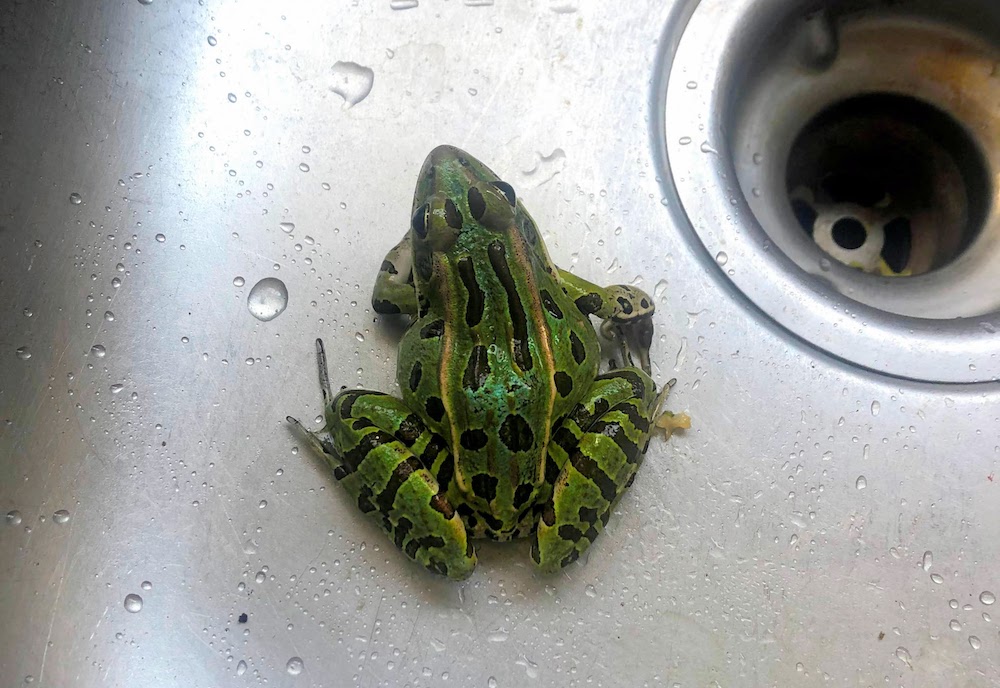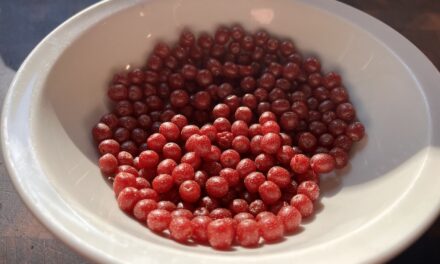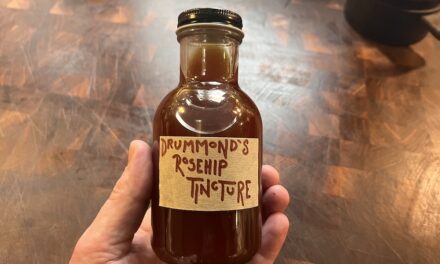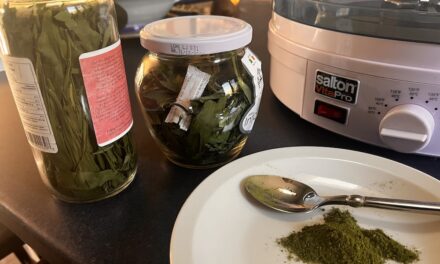Dear readers, please allow me to introduce you to the Northern Leopard Frog (Lithobates pipiens), in my mind, one of the tastiest critters one will find in the woods. Pictured here in the sink at our cabin, just before he made an escape attempt.
Good Food Revolution Trigger Warning (as we really don’t like to upset our readership):
Before we go any further, the following article contains both imagery and text concerning the hunting, skinning, gutting, and preparation of the Northern Leopard Frog that some may find distressful and/or distasteful.
For over a decade or so I have observed that as a culture we are becoming less and less attached to the earth that supports us with each passing day, and indeed it was co-founder Malcolm Jolley’s and my own mutual concerns about this that led to the founding of Good Food Revolution way back in 2010.
Today, when we get hungry for protein, most run to the supermarket and pick up a pack of shrink-wrapped meat, seldom giving a second thought as to how that meat got to the grocery shelf. And so, with a view to getting closer to the source of my food than most would be comfortable with, I decided in the fall of 2016 (mere days after the US election – no coincidence there) to learn how to hunt.
Running in parallel to my new found interest (read: midlife crisis) came a related passion for self-sufficiency that upon occasion flirted with the concept of survivalism. Being a voracious information sponge, I gorged upon mountains of books and websites, and in my deep-dives I read over and over again that if the world did really fall apart and one had to live off the land, it wouldn’t be big game that one would be surviving upon, it would be the smaller critters: rabbit, hare, squirrel… and in the case of this particular piece, the lowly frog.
Although the consumption of these amphibians is not particularly common in Canada, frogs are eaten around the world, most notably in France, the US, Thailand, Spain, China and Indonesia; Indonesia exports some 10 million pounds of frog meat annually, mainly to France and the US.
Frog’s legs are extremely rich in protein, omega-3 fatty acids, vitamin A, and potassium.
Historically it is rumoured that in 12th century France, the Catholic church decided that their monks were looking a little too chubby, and so decreed that the period that over which monks would fast (i.e. not eat meat) would be extended, in order for them to lose a little weight. To get around this the monks argued that frogs were fish, and not meat, and hence began consuming large quantities of them. This culinary habit gradually grew and grew across France.
Frogs legs are often associated with the Cajun cuisine of the bayous of Louisiana, and there is a good reason for this. In the 17th century frog-loving French colonists found their way to what is now known as Louisiana, and today that is where the largest concentrations of their descendants reside, and where most of those Indonesian frogs legs exported to the US are consumed.
Saying that, prior to colonization, Bullfrogs are reported to have been occasionally consumed by the Richibucto Micmac (Mi’kmaq), the Onondaga Iroquois, and other Micmac. The Micmac did not particularly enjoy frogs, but ate Bullfrogs when no other food was obtainable.
The Micmac cooked Bullfrogs by frying them in fat, or boiling them. The Onondaga Iroquois first skinned the Bullfrogs, put them onto pointed sticks to broil, and salted them before eating. The Richibucto Micmac preferred the legs of the Bullfrog
In the 1880’s a New Orleans chef named Donat Pucheu began introducing frog’s legs to non-Cajun palates, spreading the concept of them as a delicacy across many states.
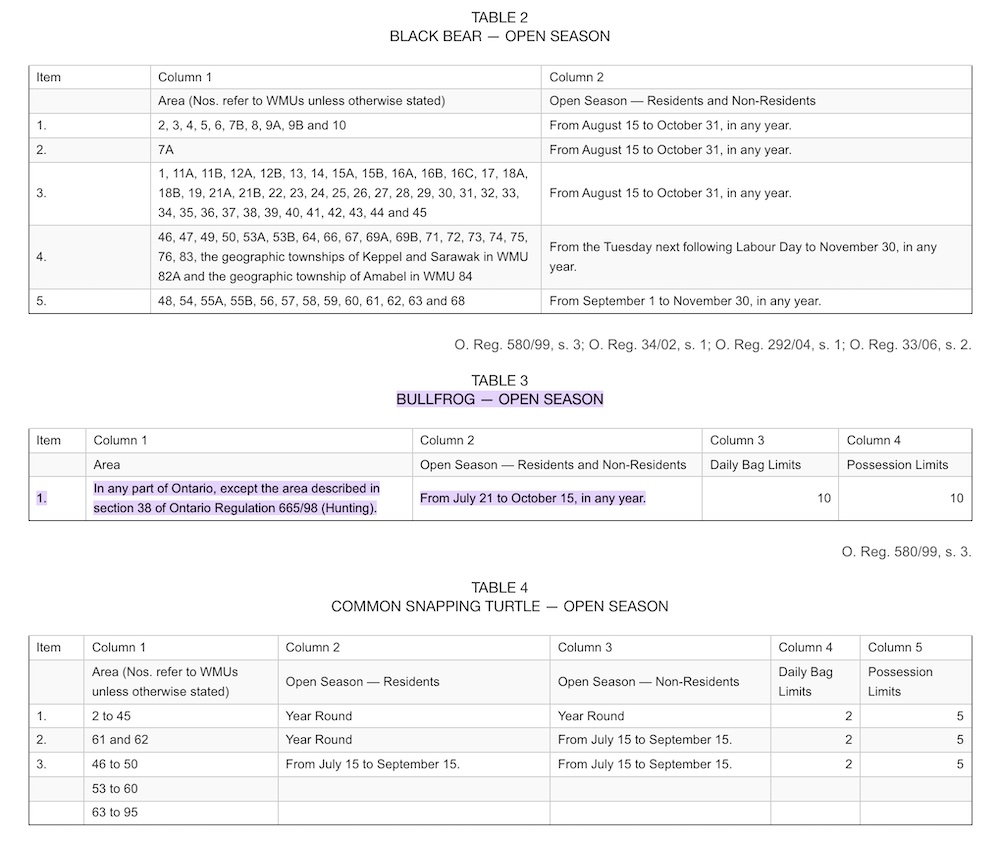
The current Ontario regulations surrounding the harvesting of frogs. On another note, who knew that snapping turtles were edible? That’s a new one to me, and perhaps a little too out-there for me to try…
Being a stickler for the law when it comes to any aspect of hunting, I’ll draw your attention to the current legislation surrounding their harvesting.
I was under the impression that frogs fell under my small game licence, but no, much like the arguments of those portly 12th century monks, frogs are classed as “fish” and one requires a Sport or Conservation fishing licence in order to be allowed to harvest them.
This year there is an open season from July 21 to October 15 in almost all Ontario WMUs (Wildlife Management Units) excepting “that part of Nogies Creek, in the townships of Galway and Harvey in the County of Peterborough, lying south of the dam at the southerly extremity of Bass Lake in the Township of Galway, and lying within Lots 9 and 10 in Concession I and Lot 9 in Concession II in the Township of Galway and Lots 27, 28, 29 and 30 in Concession XVII and Lots 27, 28, 29, 30, 31 and 32 in Concession XVI in the Township of Harvey… … A person shall not hunt bullfrogs in The Regional Municipality of Ottawa-Carleton, the counties of Prescott and Russell, Stormont, Dundas and Glengarry, Leeds and Grenville, Lanark, Frontenac, Lennox and Addington, Prince Edward, Northumberland, Peterborough and Victoria, or in the townships in the County of Hastings south of, and including, the townships of Marmora and Lake, Tudor and Cashel, and Elzevir and Grimsthorpe.”
Well, that was rather specific, wasn’t it?
Also, a person shall not hunt a bullfrog by means of a firearm other than a long-bow or crossbow. Considering all of my bows are all designed to take out deer, I’m thinking that to use one of those would be overkill.
Some people swear by using a gigger (read a long spear with a trident-like tip), but personally I find that pretty barbaric. Perhaps in a survival situation, sure, but for the time being I’m going to stick with a net and a bucket.
It’s also permitted to go out at night with a flashlight and net, startling the frogs with the bright beam like the proverbial frog deer-in-the-headlights and scooping them up.
The possession limit (that is how many one is allowed to posses overall, even in your fridge/freezer) is 10, and this is also the daily bag limit for when one is out in the field.
Commercial sale of frogs and/or their legs is strictly prohibited.
It’s not in the regulations, but I tend to leave the small frogs alone and only go for the larger Northern Leopard Frogs or American Bullfrogs. See the pics above and below to assist with your identification. The Northern Leopard is the easiest to identify due to its unique markings and prominent dorsolateral folds (folds of skin running down each side of the back) with a white belly that occasionally has a yellowish tinge. In my relatively limited experience, it is also the tastiest.
Beware of the Pickerel Frog (Lithobates palustris), the only poisonous frog found in Canada and the US. It is decidedly brown in colour and shouldn’t be mistaken for either of the edible species I mention.
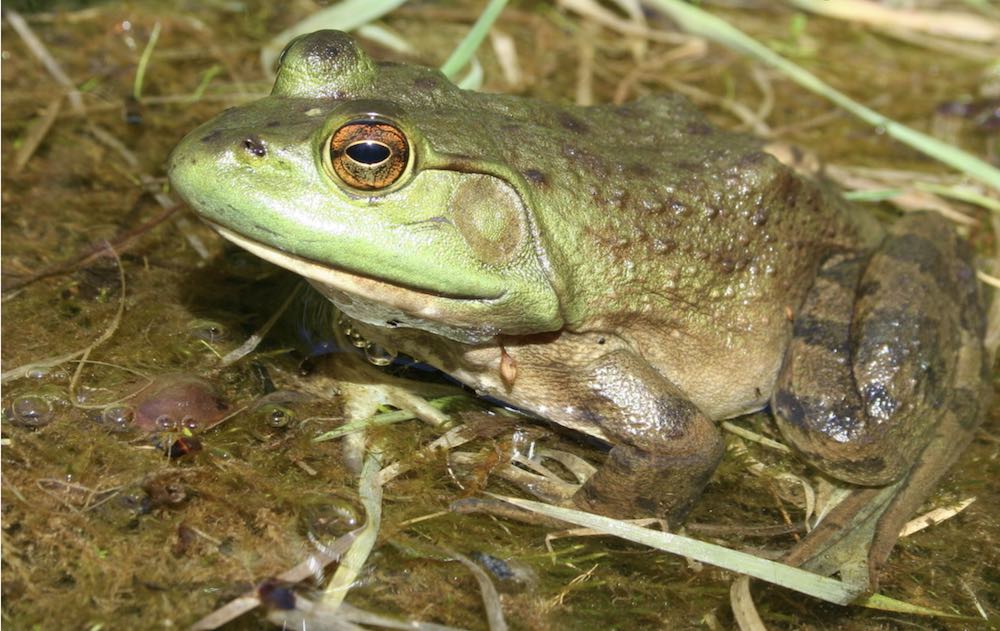
The two most common edible species one will find in Canada are the American Bullfrog (Lithobates catesbeianus) pictured above, and the Northern Leopard Frog (Lithobates pipiens) pictured at the top of this piece.
So, let’s say that you now have a bucket of 10 frogs, your legal limit, and just enough for three/four people as a starter, and they are all hopping about like mad in there.
What to do next?
Well… don’t do what I did and put them in the kitchen sink, as these little fellows can jump a hell of a distance. Yes, I had to deal with the Great Escape as they jumped under my kitchen sink and into the labyrinth nooks and crannies of my pot cupboards. Cue me losing my mind trying to recapture all the little blighters.
Dispatching them humanely isn’t quite as simple a task as one may think, as they are incredibly slippery. One method is to use blunt force to stun the frog, followed by removal of the head with a very sharp knife. Swift decapitation is tricky and, as those of you who ever went through the dissection of such creatures in high school biology class will possibly remember, leads to the rather unnerving twitching of the legs and swivelling of the eyeballs many, many minutes after the head has been removed from the body.
Another tried-and-tested method is to first put them in the fridge for 30 minutes, and then into the freezer for another 30, hence putting them into sleepy hibernation mode, allowing one to take their heads off with relative ease.

Decapitation is surely the most humane method of dispatch, but it can be made much less tricky by utilising the fridge/freezer combo trick favoured by many a “good ol’ boy”.
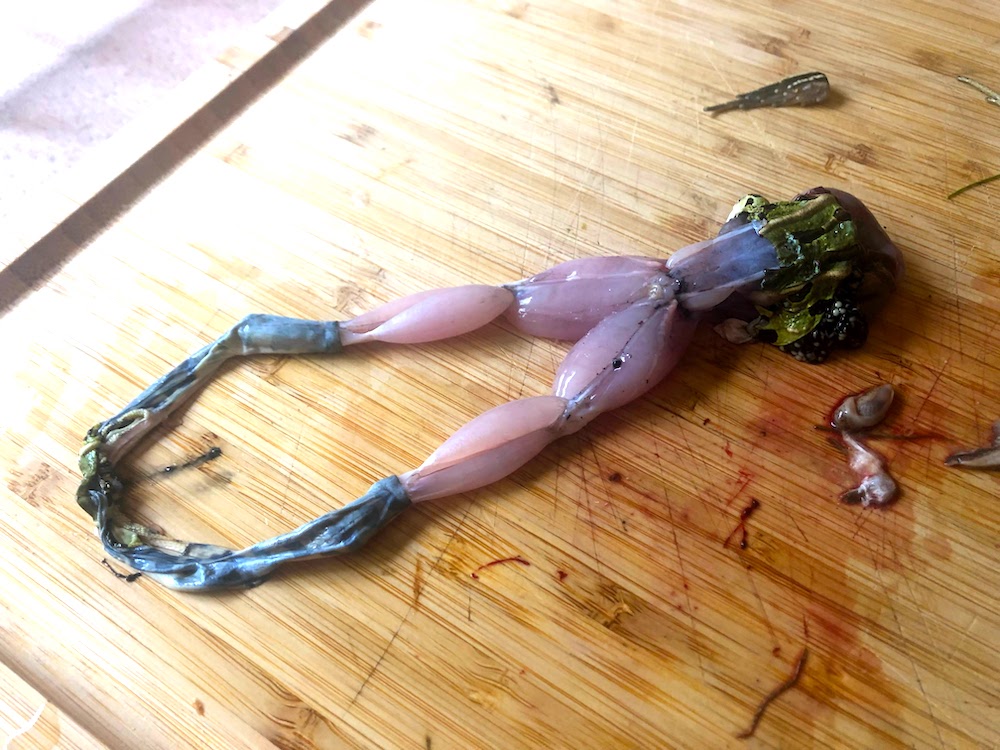
With a very sharp pair of kitchen shears or scissors snip off the feet and then cut the tough, loose skin around the waistband of the frog, then pull the skin downwards as if one were pulling down the trousers of a little GI Joe/Action Man. Yeah, it’s slightly weird, but that’s what it looks like. My son even pointed out that it looked like a wee bare bum. And it does.

Pull off the skin and discard before chopping off the legs at the waistband. Divide the two legs with a sharp knife and trim off any entrails left at the top of both legs. Some also prepare the shoulders of the frog but, to be honest, those are some slim pickings there, so I plump for solely the legs. Take all of your legs and soak them in milk in the fridge for at least an hour to draw out any impurities and plump up the legs.

After at least an hour in the milk, remove the legs and rinse well, patting dry. Roll them in a mixture of flour, garlic powder, salt, and pepper. There are many other preparations out there, but I find this to be the very simplest and quite delicious.

In some hot oil or butter sautée the little legs until they appear crispy on the outside. My olive oil got a little too hot here.

And there you have it, two slightly overcooked frog’s legs, but they were absolutely delicious. Highly recommended by both our son and me He was so very upset when we had finished them all off. We have a convert, and he’ll be asking for them all the bloody time now, not that I mind.
So, in closing, the big question is “Do they taste like chicken?”.
In short, I guess they do?
I’d be more comfortable saying they taste like frog, as there is a discernible fish-like character to the meat, but don’t let that put you off.
Nevertheless, having taught myself to catch and prepare this oft-maligned delicacy, I’ll certainly be doing the same again up until the second week of October.
Happy froggin’ (as they say).

